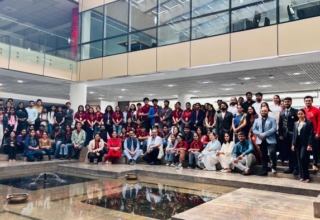
By Nien Siao, Dean, JS Institute of Design, New Delhi
 These days, Indian high school graduates are quite familiar with the digital design industry. In fact, many of them are more up-to-date on the latest trends compared to students from previous decades. With the number of design colleges growing in the country and increasing opportunities for studying abroad, it’s no wonder that many Indian students are considering or opting for a career in design. These options not only tap into your natural talents and skills but also promise a fulfilling and dynamic career ahead.
These days, Indian high school graduates are quite familiar with the digital design industry. In fact, many of them are more up-to-date on the latest trends compared to students from previous decades. With the number of design colleges growing in the country and increasing opportunities for studying abroad, it’s no wonder that many Indian students are considering or opting for a career in design. These options not only tap into your natural talents and skills but also promise a fulfilling and dynamic career ahead.
Today, the world of design is evolving, offering better opportunities for everyone to thrive. Whether you’re still in high school or just about to graduate, there’s a plethora of exciting career paths waiting for you. Whether you’re studying science, arts, or commerce, if you’re gearing up for 12th grade or preparing for your final exams, it’s worth exploring these thrilling career possibilities in design.
Here are some hot job roles to increase your understanding about careers in design:
Game Design:
Game design involves creating the rules, mechanics, and structure of a game to provide players with engaging experiences. It encompasses various elements such as storytelling, level design, character development, and user interaction. Game designers utilize creativity, technical skills, and player feedback to craft immersive worlds and compelling gameplay that captivate audiences across diverse gaming platforms.
User Experience (UX) Design:
UX designers focus on enhancing the usability, accessibility, and overall experience of digital products and services. This interdisciplinary field requires a deep understanding of user behavior, psychology, and design principles. UX designers collaborate closely with researchers, developers, and stakeholders to create intuitive and user-friendly interfaces for websites, mobile apps, and other digital platforms.
User Interface (UI) Design:
UI designers focus on designing the visual elements and interactive components of digital interfaces, such as buttons, menus, and navigation systems. They strive to create visually appealing layouts that enhance user engagement and facilitate seamless interactions. UI designers must have a keen eye for detail, typography, and color theory, along with proficiency in design software and prototyping tools.
Motion Graphics Design:
Motion graphics designers specialize in creating animated visual content for various media platforms, including films, television, advertisements, and online videos. This dynamic field combines traditional design principles with animation techniques to convey messages effectively and engage audiences visually. Motion graphics designers often work closely with video editors and animators to bring concepts to life.
Visual Communication Design:
Visual communication designers play a crucial role in creating visual concepts that communicate ideas, inspire, and inform consumers. With the rise of digital media and online platforms, graphic designers are in high demand across industries such as advertising, branding, publishing, and web design. Proficiency in software tools like Adobe Photoshop, Illustrator, and InDesign is essential for success in this field.
AI Designer:
With the integration of artificial intelligence (AI) into design processes, AI designers utilize machine learning algorithms to automate tasks, personalize user experiences, and generate innovative design solutions.
To sum up, navigating the evolving landscape of design requires a blend of creativity, technical proficiency, and adaptability to emerging trends. By embracing innovative technologies, sustainable practices, and inclusive design principles, designers can carve out successful career paths while making meaningful contributions to society and the environment. As the digital design industry continues to evolve, staying curious, collaborative, and forward-thinking will be key to thriving in this dynamic field.
Well, it is not over as yet, here is a brief listing of Key Tech and other trends shaping design industry as well as the world of design is constantly changing:
Artificial Intelligence (AI) Integration:
AI is revolutionizing the design industry by automating repetitive tasks, analyzing vast amounts of data to derive insights, and enabling personalized user experiences. AI-powered tools such as generative design software, predictive analytics, and chatbots are increasingly being adopted across various design disciplines.
Sustainability and Eco-conscious Design:
With growing environmental concerns, there is a rising demand for sustainable design practices that minimize waste, reduce carbon footprints, and prioritize eco-friendly materials. Designers are incorporating principles of circular design, upcycling, and renewable energy solutions into their projects to promote sustainability.
Augmented Reality (AR) and Virtual Reality (VR):
AR and VR technologies are transforming how users interact with digital content, offering immersive and interactive experiences across industries such as gaming, education, retail, and architecture. Designers are leveraging AR and VR to create realistic simulations, virtual prototypes, and engaging storytelling experiences.
Minimalism and Simplified Design:
In a cluttered digital landscape, minimalist design principles emphasizing simplicity, clarity, and functionality are gaining traction. Clean layouts, ample white space, and intuitive navigation enhance user engagement and promote a seamless user experience.
Inclusive Design and Accessibility:
Designing with inclusivity in mind involves ensuring that products, services, and environments are accessible to individuals of all abilities and backgrounds. From accessible web design to inclusive product packaging, designers are embracing universal design principles to cater to diverse user needs and preferences.
Biophilic Design:
Inspired by nature, biophilic design integrates natural elements such as plants, sunlight, and water into built environments to enhance well-being, productivity, and creativity. Biophilic design principles are being incorporated into interior spaces, urban planning, and architectural projects to reconnect people with the natural world.
Data-driven Design Decisions:
Data analytics and user research play a crucial role in informing design decisions, enabling designers to gain insights into user behavior, preferences, and trends. By analyzing user feedback, heatmaps, and A/B testing results, designers can iteratively improve their designs to better meet user needs and expectations.








